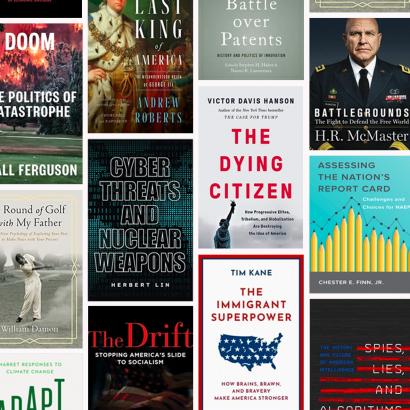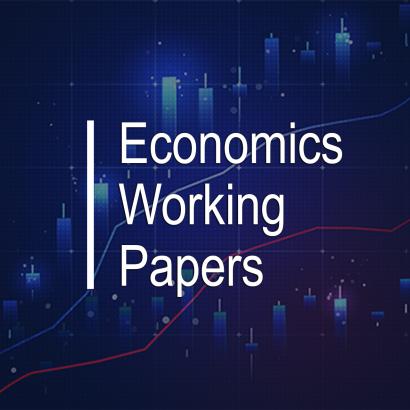In January 1969, two months after I had turned eighteen, I read that the last official act of Lyndon Johnson’s administration was to bring an antitrust suit against IBM for monopolizing the market for mainframe computers. I was angry. You might wonder why. Was it because the lawsuit would waste resources of both IBM and taxpayers? It did do that, but my anger was more fundamental. IBM had worked hard for its position, and it seemed to me that it was being punished for succeeding and for producing something that companies wanted to buy. “No one gets fired for buying IBM” was a well-known slogan at the time.
I hadn’t yet gone into economics—I was in my second year as a math major—but had, months earlier, read an article on antitrust in Ayn Rand’s book of essays titled Capitalism, The Unknown Ideal. From the late 1980s to the early 2000s, the article’s author, whom I hadn’t heard of, was to become probably the most well-known economist in America. His name: Alan Greenspan. Greenspan laid out the history of antitrust law in the United States and ended his short essay with a quote from federal judge Learned Hand on the famous Alcoa case of the mid-twentieth century.
I’ll cut to the chase. What was wrong with Judge Hand’s reasoning is what’s wrong with so much of what people, even including many economists, believe today about monopoly. Fortunately, someone who has a somewhat better understanding than Judge Hand is federal judge Amit Mehta. After having found that Google monopolized the search engine market, he could have come up with even more drastic remedies than he did. While his remedies are extreme, Mehta avoided the worst remedies that the Justice Department’s Antitrust Division favored. Moreover, his reasoning shows that he shares the same view that Alan Greenspan had in the late 1950s and that I had in the late 1960s.
That view is that the best weapon to get competition with big firms that dominate is to allow competition, not to break up the big firms. Either dominant firms will retain their dominance by remaining on the cutting edge and cutting costs, or they will lose their position to new competition. Either way, we consumers gain.
The Alcoa case
The Aluminum Company of America (Alcoa) was an amazing success. Although Greenspan didn’t give the numbers about its growth, economist Joseph Schumpeter had done so in his 1942 classic, Capitalism, Socialism, and Democracy.
Here’s a quote from his footnote about Alcoa:
From 1890 to 1929 the price of the basic product of this single seller [Alcoa] fell to about 12 percent or, correcting for the change in the price level (B.L.S. index of wholesale prices), to about 8.2 percent. Output rose from 30 metric tons to 103,400. Protection by patent ceased in 1909.
That means that Alcoa’s aluminum output over those thirty-nine years increased by over 344,665 percent! This amounts to a compounded annual rate of increase of 23 percent. Keep in mind that economists’ objection to monopoly is that the monopolist sells too little and charges too much. But a 91.8 percent fall in the price over that time, along with a 344,665 percent increase in output, suggests, to put it mildly, that restriction of output and monopoly prices were not a problem.
In 1937, the Justice Department sued Alcoa for monopolizing the market for aluminum and demanded that it be broken up. The case went before federal judge Learned Hand. Hand wasn’t just some guy. Of all the federal judges at the time who had not made it to the Supreme Court, he was arguably the most famous and accomplished one. In 1945, Judge Hand, in United States v. Alcoa, concluded that Alcoa had monopolized the market. Alcoa had argued that it had come by its monopoly honestly, that it had not purposely tried to attain a monopoly. It’s possible that it had tried to monopolize. What’s astounding, though, is Judge Hand’s reasoning about how he thought it had tried to monopolize. In one of the most quoted paragraphs ever from an antitrust decision, Judge Hand stated:
It was not inevitable that it should always anticipate increases in the demand for ingot and be prepared to supply them. Nothing compelled it to keep doubling and redoubling its capacity before others entered the field. It insists that it never excluded competitors; but we can think of no more effective exclusion than progressively to embrace each new opportunity as it opened, and to face every newcomer with new capacity already geared into a great organization, having the advantage of experience, trade connections, and the elite of personnel.
In short, Alcoa kept anticipating increases in demand for aluminum and kept increasing capacity so that it could meet that demand. It’s easy to see why Alan Greenspan concluded, in his 1962 article “Antitrust,” that “ALCOA is being condemned for being too successful, too efficient, and too good a competitor.”
The Google case
That brings us to the recent antitrust case against Google, United States v. Google LLC (2020). During President Trump’s first term, his Justice Department sued Google for monopolizing the search engine and search advertising markets. In August 2024, federal judge Amit Mehta of the District Court for the District of Columbia found Google liable for monopolizing those markets. Earlier this month, he announced his remedies. Some of them are extreme. Brian C. Albrecht, chief economist at the International Center for Law and Economics, summed up the remedies as follows:
- No exclusive contracts for Search/Chrome/Assistant/Gemini - Must share some search index metadata (one-time) - Must offer syndication to rivals - 6-year term.
Albrecht’s X (aka Twitter) thread on the decision, by the way, is essential reading.
Google put substantial resources over the years into building its metadata. Why should it be forced to share these data with rivals? Judge Mehta, an obviously ambitious lawyer, probably put effort into building a list of contacts who would help him get his current job. He was competing against others who didn’t have access to his data. Would Judge Mehta think it fair for a court to order him to share his list? Also, making Google share its index will signal to future companies that they may have to share their data with rivals. That will reduce the incentive to build such indexes in the future.
What Albrecht and others have rightly celebrated is that Judge Mehta did not require Google to sell Chrome, its highly successful search engine.
Why do I think Mehta did better than Judge Hand had done in the Alcoa case? The reason is that he understood that competition is dynamic. Specifically, improvements in technology that competitors bring to the market can be relied on to limit monopoly power in the long run. Moreover, the long run isn’t necessarily very long. Indeed, since the case began in 2020, AI technologies have come to the forefront.
Here’s how Mehta put it on the first page of his 230-page decision:
The emergence of GenAI [generative AI] changed the course of this case. No witness at the liability trial testified that GenAI products posed a near-term threat to GSEs [general search engines]. The very first witness at the remedies hearing, by contrast, placed GenAI front and center as a nascent competitive threat.
Toward the end of his decision, Mehta wrote:
On the other hand, the court is mindful that “ ‘continuing supervision of a highly detailed decree’ could wind up impairing rather than enhancing competition,” Alston, 594 U.S. at 102 (quoting Trinko, 540 U.S. at 415), and “that markets are often more effective than the heavy hand of judicial power when it comes to enhancing consumer welfare,” id. at 106. Plaintiffs’ proposed 10-year term runs the risk of growing stale in these fast-moving times, where GenAI technologies are breaking barriers seemingly at light speed. For the first time in over a decade, there is a genuine prospect that a product could emerge that will present a meaningful challenge to Google’s market dominance.
His thinking brings to mind the aforementioned Joseph Schumpeter’s insights about competition. When Schumpeter wrote Capitalism, Socialism, and Democracy, far too many economists thought of perfect competition, which involves competing only on price, as the be-all and end-all. Schumpeter saw it differently. In a chapter titled “The Process of Creative Destruction,” he wrote:
But in capitalist reality as distinguished from its textbook picture, it is not that competition [price competition] which counts but the competition from the new commodity, the new technology, the new source of supply, the new type of organization (the largest scale unit of control for instance)—competition which commands a decisive cost or quality advantage and which strikes not at the margins of the profits and the outputs of the existing firms but at their foundations and their very lives.
He went on to write, “It is hardly necessary to point out that competition of the kind we now have in mind acts not only when in being but also when it is merely an ever-present threat. It disciplines before it attacks.”
Schumpeter ended the chapter by saying that neglecting the kind of competition he described above “neglects all that is most typically capitalist about it.” In his memorable phrasing, “it is like Hamlet without the Danish prince.”
Google versus ChatGPT
Here’s an interesting case study of how one competitor to Google, ChatGPT, is already eating Google’s lunch. Two months ago, a friend of mine moved from San Francisco to Florida. Shortly after, he noticed what looked like eczema on his skin. He tried to get help from Google but didn’t get much. So, he took a picture and showed it to ChatGPT. ChatGPT told him it was a mosquito bite. Mosquito bites are rare in San Francisco and common in Florida, but he hadn’t thought of that.
His wife went out and bought a product to kill mosquitos. But when he went to use it, she had thrown away the packaging and he didn’t know what it was. So, he showed a picture to ChatGPT and got an immediate answer. As a bonus, it told him that this product was good to combat fruit flies but was hopeless in dealing with mosquitos. He asked it to recommend something. ChatGPT did so and told him where to find it. He bought it and it worked.
My friend told me that he uses ChatGPT multiple times a week. Occasionally, he compares its results with Google’s. To him, it’s no contest.
The lesson from the IBM case
Sometimes when I argue that competition, if allowed, will undercut monopoly power, I am accused of having faith in the market. But my retort is that of Thomas Sowell, who, as on many issues, said it so well: “I don’t have faith in the market; I have evidence about the market.”
Go back to the January 1969 antitrust charge against IBM. It is true that, as an eighteen-year-old, I did have faith in the market. Now I have evidence about the market versus government. On May 19, 1975, fully six years after the IBM case was filed, it went to trial. Here’s what Historyofinformation.com says:
After thousands of hours of testimony (testimony of over 950 witnesses, 87 in court, the remainder by deposition), and the submission of tens of thousands of exhibits, on January 8, 1982, the antitrust case US v. IBM was withdrawn on the grounds that the case was “without merit.”
That same site notes that the case generated 30 million pages of documents.
The wheels of justice—and of injustice—move slowly.
I remember well when it ended because I was following government policy closely. The person who ended it was no-nonsense guy William Baxter, the assistant attorney general in charge of the Justice Department’s Antitrust Division. Baxter was on leave from Stanford University’s law school. He saw what many of us saw: competition was already undercutting IBM’s dominant position. IBM’s flagship computer was the System/360. In the 1960s, the midrange 360 was priced at about $246,000, which is $2.5 million in today’s dollars. IBM had quit marketing the 360 at the end of 1977. What does that tell you? What it told Baxter—along with, I’m sure, other evidence—was to drop the case.
And, of course, we know what happened within a few years after the case was dropped. We got cheap desktop computers that sold for less than 1 percent of the 360’s price. I asked ChatGPT, not Google, “When did cheap desktop computers overtake the capabilities of IBM’s 360 computer?
In under fifteen seconds, I got this answer:
Late 1980s (80386 at 20–25 MHz): 3–5 MIPS [million instructions per second]—surpassing even high-end 360/75 models. By the Pentium era (1993+): desktop machines were orders of magnitude faster than any System/360.
That’s evidence, not faith.

















